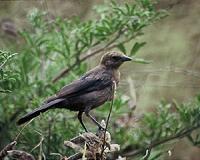 |
West Lafayette IN (SPX) Mar 10, 2011 Using genetic methods to count endangered eagles, a group of scientists showed that traditional counting methods can lead to significantly incorrect totals that they believe could adversely affect conservation efforts. Andrew DeWoody, a professor of genetics at Purdue University; Jamie Ivy, population manager at the San Diego Zoo; and Todd Katzner, a research assistant professor at the University of West Virginia, found that visual counts of imperial and white-tailed sea eagles in the Narzum National Nature Reserve of Kazakhstan significantly underestimated the imperial eagle population there. Using DNA from eagle feathers gathered in the area, the researchers were able to identify individual DNA fingerprints for each bird. The technique showed that there were 414 eagles, more than three times as many as had been visually observed, and more than two and a half times more than modeling suggested would be there. "A biologist doesn't always see them coming and going," said DeWoody, whose findings were published in the early online version of the journal Animal Conservation. "Eagles are difficult to capture, mark and resight. Biologists in the field can't differentiate individuals, whereas by a genetic fingerprint geneticists can differentiate among individuals that have visited a site." DeWoody, Ivy and Katzner, with collaborator Evgeny Bragin of the Narzum Natural Nature Reserve collected thousands of eagle feathers around roosts and nesting sites. DeWoody's team at Purdue was able to extract DNA from those feathers and determine that there were hundreds of eagles that had recently visited the site. "Generally we say 'what you see is what you get,' but in this case it's the complete opposite," said Katzner, who used the data to model more accurate estimates of eagle populations. "When your field data are off by that much, it's difficult to build accurate models because your starting point is just so far off." DeWoody and Katzner said accurate animal counts are an important part of conservation practices. If populations are underestimated, it could signal to decision makers that a habitat isn't important when, in reality, more animals are using it than thought. Conversely, if a population is more abundant than once thought, resources may need to be reallocated. "We don't want to spend a lot of effort protecting a species that doesn't need that much protection," DeWoody said. "This is a science-based approach to conservation." In the case of eagles in Kazakhstan, Katzner said the new population estimates show that the Narzum National Nature Reserve is a more important site than previously thought. "We knew it was an important site for eagles, but we seriously underestimated its importance," Katzner said. "We used to think this was only an important site for breeders, but now we know this is an important site for birds from several life stages." The data will be used to begin discussions about managing resources for eagles in Kazakhstan. DeWoody hopes that the findings will increase funding to use the technique on other threatened or endangered species. He said of particular interest to him is the Steller's sea eagle, a bird native to northeast Asia and thought to have a population of only a few thousand. A National Science Foundation fellowship, the National Geographic Society, National Birds of Prey Trust and Wildlife Conservation Society funded the study.
Share This Article With Planet Earth
Related Links Purdue University Darwin Today At TerraDaily.com
 Fossil Bird Study Describes Ripple Effect Of Extinction In Animal Kingdom
Fossil Bird Study Describes Ripple Effect Of Extinction In Animal KingdomGainesville FL (SPX) Mar 09, 2011 A University of Florida study demonstrates extinction's ripple effect through the animal kingdom, including how the demise of large mammals 20,000 years ago led to the disappearance of one species of cowbird. The study shows the trickle-down effect the loss of large mammals has on other species, and researchers say it is a lesson from the past that should be remembered when making conserva ... read more |
|
| The content herein, unless otherwise known to be public domain, are Copyright 1995-2010 - SpaceDaily. AFP and UPI Wire Stories are copyright Agence France-Presse and United Press International. ESA Portal Reports are copyright European Space Agency. All NASA sourced material is public domain. Additional copyrights may apply in whole or part to other bona fide parties. Advertising does not imply endorsement,agreement or approval of any opinions, statements or information provided by SpaceDaily on any Web page published or hosted by SpaceDaily. Privacy Statement |